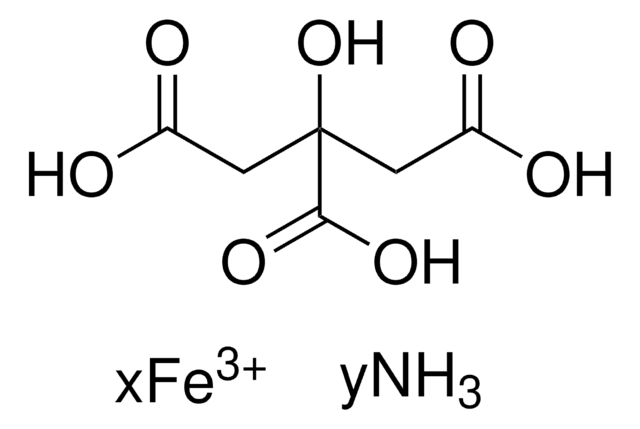44941
Iron(III) citrate tribasic monohydrate
18-20% Fe basis (T)
Sinonimo/i:
Ferric citrate monohydrate
About This Item
Prodotti consigliati
Livello qualitativo
Forma fisica
solid
Concentrazione
18-20% Fe (T)
Anioni in tracce
chloride (Cl-): ≤500 mg/kg
Cationi in tracce
Ca: ≤100 mg/kg
Cd: ≤50 mg/kg
Co: ≤50 mg/kg
Cu: ≤50 mg/kg
K: ≤500 mg/kg
Na: ≤200 mg/kg
Ni: ≤100 mg/kg
Pb: ≤50 mg/kg
Zn: ≤50 mg/kg
Gruppo funzionale
hydroxyl
Stringa SMILE
OC12CC(=O)O[Fe](OC(=O)C1)OC2=O
InChI
1S/C6H8O7.Fe/c7-3(8)1-6(13,5(11)12)2-4(9)10;/h13H,1-2H2,(H,7,8)(H,9,10)(H,11,12);/q;+3/p-3
NPFOYSMITVOQOS-UHFFFAOYSA-K
Cerchi prodotti simili? Visita Guida al confronto tra prodotti
Applicazioni
Avvertenze
Warning
Indicazioni di pericolo
Consigli di prudenza
Classi di pericolo
Eye Irrit. 2
Codice della classe di stoccaggio
13 - Non Combustible Solids
Classe di pericolosità dell'acqua (WGK)
WGK 2
Punto d’infiammabilità (°F)
Not applicable
Punto d’infiammabilità (°C)
Not applicable
Dispositivi di protezione individuale
Eyeshields, Gloves, type N95 (US)
Scegli una delle versioni più recenti:
Possiedi già questo prodotto?
I documenti relativi ai prodotti acquistati recentemente sono disponibili nell’Archivio dei documenti.
I clienti hanno visto anche
Il team dei nostri ricercatori vanta grande esperienza in tutte le aree della ricerca quali Life Science, scienza dei materiali, sintesi chimica, cromatografia, discipline analitiche, ecc..
Contatta l'Assistenza Tecnica.













